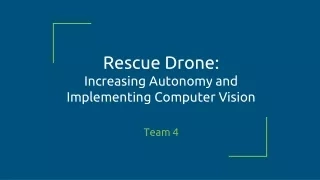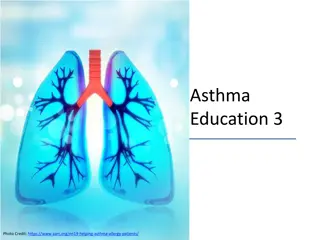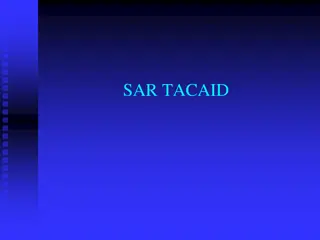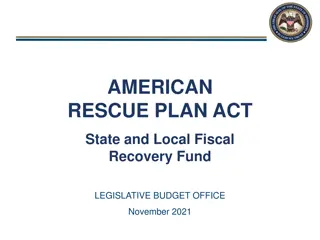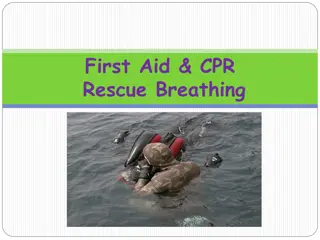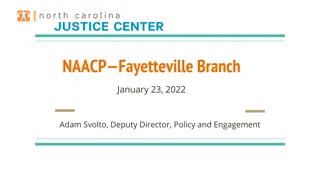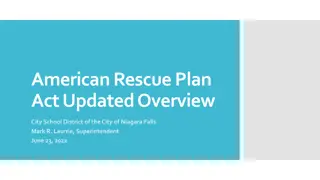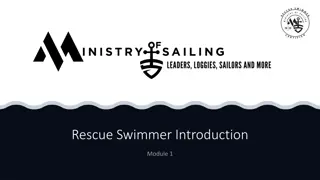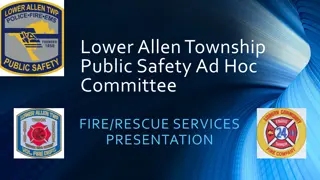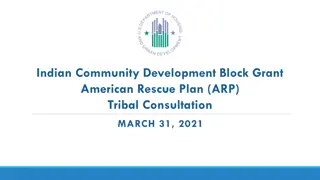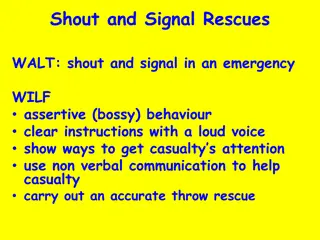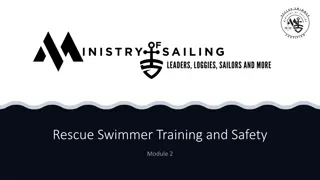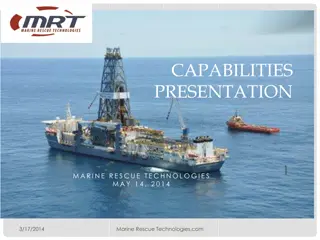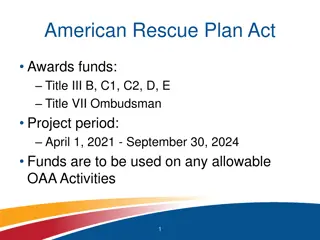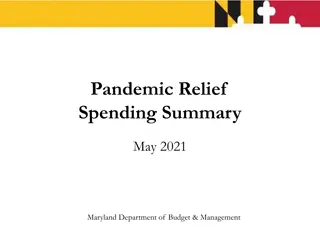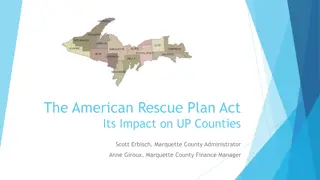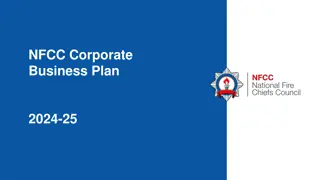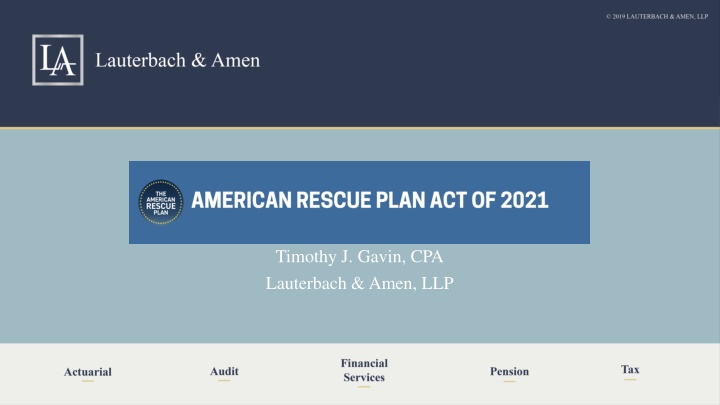
American Rescue Plan Act Funding Distribution
Discover the breakdown of the American Rescue Plan Act funding distribution, including details on emergency funding, eligibility criteria, and how to spend the funds to respond to the pandemic's economic impacts. Stay informed on the allocation process for municipalities, counties, and states, and the restrictions and requirements involved in utilizing the funds effectively.
Download Presentation

Please find below an Image/Link to download the presentation.
The content on the website is provided AS IS for your information and personal use only. It may not be sold, licensed, or shared on other websites without obtaining consent from the author. If you encounter any issues during the download, it is possible that the publisher has removed the file from their server.
You are allowed to download the files provided on this website for personal or commercial use, subject to the condition that they are used lawfully. All files are the property of their respective owners.
The content on the website is provided AS IS for your information and personal use only. It may not be sold, licensed, or shared on other websites without obtaining consent from the author.
E N D
Presentation Transcript
American Rescue Plan Act Timothy J. Gavin, CPA Lauterbach & Amen, LLP
Coronavirus State and Local Fiscal Recovery Funds 2
Whats Coming? $350 billion in emergency funding - $130 billion for local governments Two distributions First within 60 days Second approximately 12 months later (unless unemployment > 2% higher) Some exceptions (entitlement vs. non-entitlement) How much are you getting? IML May 10 update: https://www.iml.org/page.cfm?key=26040 IML direct link to March 8 estimates: https://www.iml.org/file.cfm?key=20922 Further guidance to come for non-entitlement municipalities 3
Whats Coming? Distribution is split up: CDBG municipalities direct from Treasury Non-CDBG funneled through the State (30 days later probably more) Counties direct from Treasury based on population Must obligate funds by 12/31/2024; projects complete by 12/31/2026 Few restrictions: States and territories cannot offset tax reductions or delay a tax increase Cannot be put into any pension fund (except for routine deposits through payroll process) 4
How to Spend In general If ok under CARES, generally ok under ARPA Updated standard of eligibility for public health and safety payrolls Cannot use for expenses related to TANs Interim final rule is non-exclusive must meet overall objectives of the Act Effectively no prior costs allowed (period begins March 3, 2021) 5
How to Spend Respond to the pandemic or its negative economic impacts Includes assistance to households, small businesses and nonprofits, or aid to impacted industries such as tourism, travel and hospitality Eligibility determination process: 1. Identify a need or negative impact 2. Identify how intervention addresses the need Must be in response to disease itself or related economic disruptions Must assess connection between negative economic harm, nature and extent of harm, and how funding addresses the harm 6
How to Spend Respond to the pandemic or its negative economic impacts Actual health-related costs are eligible broad category Impact on households, individuals, and businesses See eligibility assessment on prior slide Recipients who did not experience negative economic harm are not eligible Aid cannot be unrelated or grossly disproportionate Unemployed workers can include those already unemployed before COVID Households food, rent/mortgage, cash assistance, home repairs, internet access, job training (and LOTS more) Small business and non-profits loans/grants to mitigate financial hardship, COVID prevention/mitigation, technical assistance, counseling, etc. 7
How to Spend Respond to the pandemic or its negative economic impacts Rehiring government staff to pre-pandemic level Includes payroll and covered benefits Impacted industries travel, hospitality Investments in housing and neighborhoods address homelessness, affordable housing, housing vouchers/facilitating moves Educational disparities could be granted to school districts Healthy childhood environments childcare, home visit programs, services for welfare-involved families 8
How to Spend Premium pay for eligible workers performing essential work Health care facility staff, farms, food production facilities, grocery stores, restaurants, janitors/sanitation, truck drivers, transit, warehouse, public health, public safety, childcare workers, teachers and school staff, social services Up to $13 per hour above regular pay, not to exceed $25,000 per worker Can also provide grants to eligible employers No telework 9
How to Spend Provision of government services to make up for lost revenue Revenue includes own source and state-shared revenue; excludes utilities, debt or investment proceeds, agency transactions Calculation of loss: base year revenue * [(1 + growth adjustment )^(n/12)] n = number of months since end of base year Growth adjustment = 4.1% or average growth over 3 years prior to COVID, whichever is higher 10
How to Spend Provision of government services to make up for lost revenue Measure at 12/31/2020, 21, 22, and 23 Example 4/30 fiscal year; $12,000,000 revenue at 4/30/2019; 4.1% growth factor; 2% actual growth after initial loss Base Year 4/30/2019 12/31/2020 20 11,800,000 $ 12,831,156 (1,031,156) $ 12/31/2021 32 12,036,000 $ 13,357,234 (1,321,234) $ 12/31/2022 44 12,277,000 $ 13,904,880 (1,627,880) $ 12/31/2023 56 12,523,000 $ 14,474,980 (1,951,980) $ n = Actual Revenue Counterfactual Revenue Loss 12,000,000 $ 11
How to Spend Example 2 4/30 fiscal year; $12,000,000 revenue at 4/30/2019; 4.1% growth factor; 3% actual growth with no initial loss Base Year 4/30/2019 12/31/2020 20 12,240,000 $ 12,831,156 (591,156) $ 12/31/2021 32 12,485,000 $ 13,357,234 (872,234) $ 12/31/2022 44 12,735,000 $ 13,904,880 (1,169,880) $ 12/31/2023 56 12,990,000 $ 14,474,980 (1,484,980) $ n = Actual Revenue Counterfactual Revenue Loss 12,000,000 $ 12
How to Spend Provision of government services to make up for lost revenue Eligible: Maintenance or cash-funded construction of infrastructure (including roads), cybersecurity, health, environmental, education, police, fire, other public safety. Not eligible: debt payments, claims and judgements 13
How to Spend Investment in water, sewer, or broadband infrastructure Water and sewer projects that would be eligible through the EPA CWSRF and DWSRF programs; establishment of drinking water systems Broadband to achieve 100 Mbps service is underserved areas (exceptions if those speeds are not feasible) 14
How to Spend Transfers Allowable to transfer to special-purpose governments (fire districts, water, sewer, park districts, libraries, etc.) All eligibility rules still apply Transferees are subrecipients and must be monitored by transferor government Transferor must report subrecipient activity 15
Accounting and Reporting Implications Uniform Guidance applies! Single audit Cost principles and restrictions Reporting Entitlement municipalities quarterly project and expenditure reports Interim report for 7/31/2021, due by 8/31/2021 First full report for 9/30/2021, due by 10/31/2021 Entitlement municipalities annual recovery plan performance report Interim report for 7/31/2021, due by 8/31/2021 First full report for 7/31/2022+, due by 8/31/2022+ Non-entitlement annual reports for 9/30, due by 10/31 16
Accounting and Reporting Implications Period of performance 3/3/2021 through 12/31/2026 Accounting in general Keep records Develop a plan Discuss with your auditor federal compliance Check with your auditor regarding their experience with federal programs 17
To Do To do right away Make sure you have an active SAM.gov account required for entitlement municipalities Make sure you have an active DUNS number required for ALL recipients https://fedgov.dnb.com/webform Entitlement governments only submit request through Treasury portal Check out IML s resource guide - https://www.iml.org/file.cfm?key=21320 18
Questions? tgavin@lauterbachamen.com linkedin.com/in/timgavincpa/ 19

